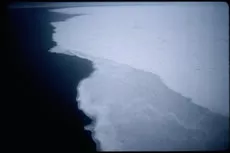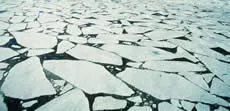Cryosphere glossary
land overlaid at present by a glacier is said to be covered; the alternative term glacierized has not found general favour.
the boundary at any given time between open water and sea, river or lake ice of any kind, whether drifting or fast; may be termed compacted when it is clear-cut, or open when it forms the indefinite edge of an area of dispersed ice.
Image

Aerial view of the sea ice edge.
Todd Arbetter, National Snow and Ice Data Center
the total area covered by some amount of ice, including open water between ice floes; ice extent is typically reported in square kilometers. Extent defines a region as either "ice-covered" or "not ice-covered." A threshold determines this labeling. A typical threshold is 15 percent, meaning that if the data cell has greater than 15 percent ice concentration, the cell is labeled as "ice-covered." Sea Ice Index products have a threshold of 15 percent. A threshold can also be as high as 30 percent.
a cohesive sheet of ice floating in the water; the sea ice cover is made up of conglomerates of floes; ice floes are not unique to sea ice, as they also occur in rivers and lakes.
Image

Aerial view of ice floes.
a suspension of numerous minute ice crystals in the air, reducing visibility at the earth's surface; the crystals often glitter in the sunshine; ice fog produces optical phenomena such as luminous pillars and small haloes.
the vertical cliff forming the seaward face of an ice shelf or other floating glacier, varying in height from 2 to 50 meters (2.2 to 55 yards) above sea level.
a form of tabular berg found in the Arctic Ocean, with a thickness of 30 - 50 meters (33 to 55 yards) and an area from a few thousand square meters to 500 square kilometers (123,550 acres); ice islands often have an undulating surface, which gives them a ribbed appearance from the air.
from the point of view of the submariner, a downward-projecting ridge on the underside of the ice canopy; the counterpart of a ridge; ice keels may extend as much as 50 meters (55 yards) below sea level.
the average position of the ice edge in any given month or period based on observations over a number of years.
precipitation of small balls or pieces of ice (hailstones) with a diameter ranging from 5 to 50 millimeters (0.2 to 2.0 inches), or sometimes more, falling either separately or agglomerated into irregular lumps; when the diameter is less that about 5 millimeters (0.2 inch), the balls are called ice pellets.
ice covering a costal strip of low-lying land backed by mountains; the surface of an ice piedmont slopes gently seawards and may be anything from 1 to 50 kilometers (0.6 to 31 miles) wide, fringing long stretches of coastline with ice cliffs; ice piedmonts frequently merge into ice shelves; a very narrow ice piedmont may be called an ice fringe.
a fall of unbranched ice crystals, in the form of needles, columns, or plates, often so tiny that they seem to be suspended in the air; these are visible mainly when they glitter in the sunshine (diamond dust); they may then produce a luminous pillar or other halo phenomena; this hydrometeor, which is frequent in polar regions, occurs at very low temperatures and in stable air masses.
a brittle, shiny crust of floating ice, formed on a quiet surface by direct freezing or from grease ice, usually in water of low salinity; thickness less than 5 centimeters (2 inches); easily broken by wind or swell, commonly breaking into rectangular pieces.